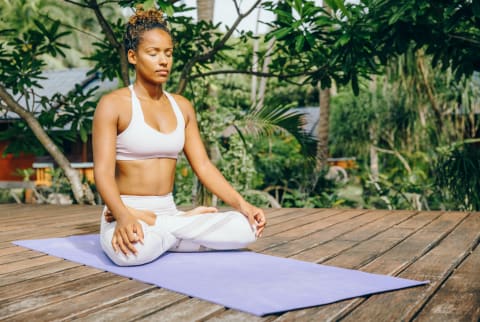Advertisement
3 One-Minute Practices To Rebalance Your Body & Mind


These techniques are a great place to start your yang sheng journey. Not only are they short, but they're based on what you already do—breathing and moving—just upgraded. Together, they will help relax your body and, the Chinese would say, release stagnant chi and move your fluids. In Western terms, you'd say they boost your circulation including your lymphatic system. These techniques are so short that they're doable daily.
One-minute rescue breath ritual
However busy you are, you have to breathe! While you may not have paid much attention to your breathing before, you'll discover it's the key to controlling your stress levels. When you're stressed, it greatly affects your digestive system, which is why focusing positive energy on this area is so beneficial. This effortless technique is powerful because it gives your mind something to focus on. It's basically a minute of easy meditation.
Start seated, lying down or standing, however you're comfortable. Breathe in through the nose, then sharply out through the mouth, sticking out your tongue and making a "Haaaaa" noise as you do so. This clears the stale air that accumulates in your lungs when you breathe shallowly. Repeat three times.
With your eyes closed, breathe in for five counts through the nose and out for five counts through the nose. Think of inhaling the oxygen deeply, to fill your chest cavity and down to your abdomen. Let your focus descend to your lower abdomen; your heart rate will slow, your blood pressure will drop, and your muscles will begin to relax. Don't worry about whether you're breathing right—the key is taking your focus down into your body.
Visualize a smile happening in your lower abdomen. Do this by recalling the warm feeling you get when you smile, then imagine sending that feeling to your lower stomach.
One-minute tapping ritual
This exercise gives your circulation a serious wake-up call, so it's a great antidote to feeling tired or sluggish. Do it on waking, then repeat regularly throughout the day, for example, every time you wash your hands. Tying it to a regular action will help you remember to do it.
With a loose fist or cupped hand, rapidly and firmly pat down the insides then up the outsides of the arms. Then, pat down the outsides and up the insides of the legs including onto the feet.
Pat in a circle around your abdomen, your lower back, all over your head and finally your thymus (between your breasts).
A word on other healing therapies: I love good treatments, and I work with some outstanding therapists. A great therapeutic relationship is a huge asset to your health, but not everyone is able to commit to regular treatments. If you can't, self-healing is a valuable alternative. If you can, use these techniques in between your sessions to amplify the benefits.
The importance of nature: Being in balance with and aligning to nature are fundamental to Taoism. I suggest one of the first changes you make is to get out into green spaces more. Immersing yourself in nature has a range of benefits, like supporting your immune system, reducing stress hormones and boosting creativity.
Stepping away from your screen and getting outside is about more than just fresh air, although that's good too. Your eyes naturally love to look at the shapes in nature, which have been proven to relax us. Seeing nature has also been shown to increase positive emotions, which boosts anti-inflammatory proteins called cytokines. Even a plant on your desk can be hugely beneficial.
Lifting the sky
Like all qigong movements, there are lots of slightly different versions of this exercise. This is one of the simplest; it will engage most of your meridians (energy channels) as well as strengthen your abdominal muscles.
Start standing, feet shoulder-width apart. Keep your eyes relaxed and half shut. Have your hands out in front at hip level, arms slightly bent, palms facing the floor with tips of fingers almost touching.
Breathe out, then engage your abdomen. Look at your hands.
Take a deep breath in and, as you do, press your hands toward the floor, then let them come up in a half circle, palms outward. Follow your hands with your eyes. Keep your palms flat and your elbows slightly bent.
When your hands reach forehead level, push upward, as though you are lifting the sky, looking up.
When your hands reach the top, breathe out as you separate your arms out to your sides and move them down in a circle. Let your arms and gaze drop back to center. Repeat for one minute.
Watch Next
Enjoy some of our favorite clips from classes
Enjoy some of our favorite clips from classes
What Is Meditation?
Mindfulness/Spirituality | Light Watkins
Box Breathing
Mindfulness/Spirituality | Gwen Dittmar
What Breathwork Can Address
Mindfulness/Spirituality | Gwen Dittmar
The 8 Limbs of Yoga - What is Asana?
Yoga | Caley Alyssa
Two Standing Postures to Open Up Tight Hips
Yoga | Caley Alyssa
How Plants Can Optimize Athletic Performance
Nutrition | Rich Roll
What to Eat Before a Workout
Nutrition | Rich Roll
How Ayurveda Helps Us Navigate Modern Life
Nutrition | Sahara Rose
Messages About Love & Relationships
Love & Relationships | Esther Perel
Love Languages
Love & Relationships | Esther Perel

















